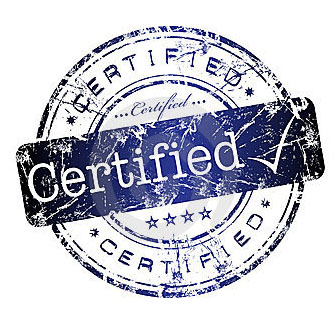|
|
| Author |
Message |
Netaddict
Joined: 16 Feb 2011
Posts: 332
Location: Earth
PS Version: CS6
OS: Windows 7 Professional
|
 Posted: Sun Sep 15, 2013 5:06 am Post subject: Hoe do they create that? Posted: Sun Sep 15, 2013 5:06 am Post subject: Hoe do they create that? |
 |
|
You know when a word or logo is stamped on a sheet of paper, it looks a bit grungy and cut up, like the attachement. Can this stamp effect be recreated in Photoshop? how?
| Description: |
|
| Filesize: |
80.38 KB |
| Viewed: |
1564 Time(s) |

|
|
|
|
|
|
 |
Rarity
Joined: 27 Nov 2012
Posts: 329
Location: The Netherlands
PS Version: CS6
OS: Windows 8
|
 Posted: Sun Sep 15, 2013 6:59 am Post subject: Posted: Sun Sep 15, 2013 6:59 am Post subject: |
 |
|
I do this with a plug-in by Mr Retro called Machine Wash Deluxe.
You could do this stuff manually by adding a grey scale grunge texture to a layer mask and tweaking the contrast to get the desired effect. Takes up a lot more time and offers way less control then the plug-in though.
_________________
Bart J.A.H. de Brouwer |
|
|
|
|
 |
Netaddict
Joined: 16 Feb 2011
Posts: 332
Location: Earth
PS Version: CS6
OS: Windows 7 Professional
|
 Posted: Tue Sep 17, 2013 1:23 am Post subject: Posted: Tue Sep 17, 2013 1:23 am Post subject: |
 |
|
I haven't used layer masks a lot so I have the following question:
After I create the text layer and rasterize it, I create a layer mask then place the grey scale grunge texture in it but instead, the grey scale grunge texture goes into a new layer!
How do I put the grey scale grunge texture in the layer mask?
|
|
|
|
|
 |
Rarity
Joined: 27 Nov 2012
Posts: 329
Location: The Netherlands
PS Version: CS6
OS: Windows 8
|
 Posted: Tue Sep 17, 2013 3:05 pm Post subject: Posted: Tue Sep 17, 2013 3:05 pm Post subject: |
 |
|
No need to rasterize the text layer. Just press the layer mask button on the bottom of your layers window - the one that looks like a rectangle with a hole in it.
To keep things simple I would recommend pasting the grunge texture and tweaking it on a new layer. Paste it in and desaturate it (Ctrl+Shift+U). Use a levels or curse adjustment on it to tweak the contrast up really high. Keep in mind we are going to paste this on the layer mask of the text layer and the blacks will be hidden and the whites will still be shown. Going for the example you posted (a decent amount of the original picture still being shown) you'd really want to lighten the stuff up a lot, but still keeping some pure blacks in there, with some smooth transitions around its edges.
Copy the tweaked texture and hide the texture layer. Now Alt-Click the thumbnail of the layer mask on the text layer and paste it in place using Ctrl+Shift+V. Now click on the thumbnail of the text layer again and you will see the texture applied. First: I would remove the link between the layer and the layer mask by clicking the small chain icon. You will now scale / move the text layer and the layer mask separately, to get the optimal position of the texture effect on your text layer.
You can still tweak the texture modifying with the layer mask selected (just by simply clicking the mask's thumbnail) and Alt-Click the thumbnail to see the effects on the mask itself, and not the mask applied on the effect.
I hope this stuff was clear, if you need me to explain stuff in more detail or provide some screenshots on curtain parts just shout out 
_________________
Bart J.A.H. de Brouwer |
|
|
|
|
 |
Netaddict
Joined: 16 Feb 2011
Posts: 332
Location: Earth
PS Version: CS6
OS: Windows 7 Professional
|
 Posted: Tue Sep 17, 2013 10:47 pm Post subject: Posted: Tue Sep 17, 2013 10:47 pm Post subject: |
 |
|
Thanks Rarity, it worked. I guess now all I need to do is find the right grunge texture. I was just looking at the image I attachd and noticed something I hadn't noticed before; other than the whit areas that have been "taken out " of the stamp, there are extra blue areas that shouldn't have been there, how di I create those.
At first a plugin sounded like a bit too much for this effect but now I'm appreciating how useful it would be
|
|
|
|
|
 |
Rarity
Joined: 27 Nov 2012
Posts: 329
Location: The Netherlands
PS Version: CS6
OS: Windows 8
|
 Posted: Wed Sep 18, 2013 11:12 am Post subject: Posted: Wed Sep 18, 2013 11:12 am Post subject: |
 |
|
http://www.cgtextures.com/texview.php?id=34635&PHPSESSID=md6cpgjr3033pibbl2cd2mdhj3
^Seems like a set I could make this work with.
Uhm for the extra blue areas, I would create a new layer and fill that layer with the colour blue, then do the exact same thing as you did with the texture for the decay, only now the other way around, a lot of black and a little bit white. (Just basically turn the levels / curves around if you get what I mean.)
You could do this, and it might even have the best result, with the same texture as the first part.
_________________
Bart J.A.H. de Brouwer |
|
|
|
|
 |
|





